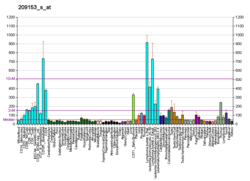Transcription factor 3 (E2A immunoglobulin enhancer-binding factors E12/E47), also known as TCF3, is a protein that in humans is encoded by the TCF3 gene.[5][6][7] TCF3 has been shown to directly enhance Hes1 (a well-known target of Notch signaling) expression.[8]
Function edit
This gene encodes a member of the E protein (class I) family of helix-loop-helix transcription factors. The 9aaTAD transactivation domains of E proteins and MLL are very similar and both bind to the KIX domain of general transcriptional mediator CBP.[9][10] E proteins activate transcription by binding to regulatory E-box sequences on target genes as heterodimers or homodimers, and are inhibited by heterodimerization with inhibitor of DNA-binding (class IV) helix-loop-helix proteins. E proteins play a critical role in lymphopoiesis, and the encoded protein is required for the B and T lymphocyte development.[5]
This gene regulates many developmental patterning processes such as lymphocyte and central nervous system (CNS) development. E proteins are involved in the development of lymphocytes.[11] They initiate transcription by binding to regulatory E-box sequences on target genes.
Clinical significance edit
Deletion of this gene or diminished activity of the encoded protein may play a role in lymphoid malignancies. This gene is also involved in several chromosomal translocations that are associated with lymphoid malignancies including pre-B-cell acute lymphoblastic leukemia (t(1;19), with PBX1 and t(17;19), with HLF),[12] childhood leukemia (t(19;19), with TFPT) and acute leukemia (t(12;19), with ZNF384).[5]
Interactions edit
TCF3 has been shown to interact with:
References edit
Further reading edit
- LeBrun DP (May 2003). "E2A basic helix-loop-helix transcription factors in human leukemia". Frontiers in Bioscience. 8 (1–3): s206–22. doi:10.2741/1030. PMID 12700034.
This article incorporates text from the United States National Library of Medicine, which is in the public domain.








